Revolutions of 1848
Revolutions of 1848
Jump to navigation
Jump to search
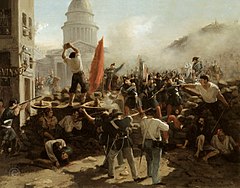 Barricade on the rue Soufflot,[1][2] an 1848 painting by Horace Vernet. The Panthéon is shown in the background. | |
| Date | 23 February 1848 – early 1849 |
|---|---|
| Location | Western and Central Europe |
| Also known as | Spring of Nations, Springtime of the Peoples, Year of Revolution |
| Participants | People of France, the German states, the Austrian Empire, the Kingdom of Hungary, the Italian states, Denmark, Wallachia, Poland, and others |
| Outcome |
|
| Part of a series on |
| Revolution |
|---|
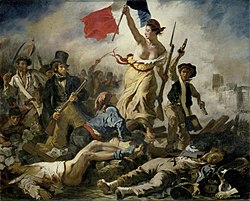 |
Types
|
Methods
|
Causes
|
Examples
|
The Revolutions of 1848, known in some countries as the Spring of Nations, People's Spring, Springtime of the Peoples,[3] or the Year of Revolution, were a series of political upheavals throughout Europe in 1848. It remains the most widespread revolutionary wave in European history.
The revolutions were essentially democratic and liberal in nature, with the aim of removing the old monarchical structures and creating independent nation states. The revolutions spread across Europe after an initial revolution began in France in February. Over 50 countries were affected, but with no significant coordination or cooperation among their respective revolutionaries. Some of the major contributing factors were widespread dissatisfaction with political leadership, demands for more participation in government and democracy, demands for freedom of the press, other demands made by the working class, the upsurge of nationalism, and the regrouping of established government forces.[4]
The uprisings were led by ad hoc coalitions of reformers, the middle classes and workers, which did not hold together for long. Tens of thousands of people were killed, and many more were forced into exile. Significant lasting reforms included the abolition of serfdom in Austria and Hungary, the end of absolute monarchy in Denmark, and the introduction of representative democracy in the Netherlands. The revolutions were most important in France, the Netherlands, the states of the German Confederation that would make up the German Empire in the late 19th and early 20th century, Italy, and the Austrian Empire.
Contents
1 Origins
1.1 Urban workers
1.2 Rural areas
1.3 Role of ideas
2 Events by country or region
2.1 Italian states
2.2 France
2.3 German states
2.4 Denmark
2.4.1 Schleswig
2.5 Habsburg Empire
2.5.1 Hungary
2.5.2 Galicia
2.6 Sweden
2.7 Switzerland
2.8 Greater Poland
2.9 Danubian Principalities
2.10 Belgium
2.11 Ireland
2.12 Other European states
2.13 Other English-speaking countries
2.14 South America
3 Legacy
3.1 In popular culture
4 See also
5 References
6 Bibliography
6.1 Surveys
6.2 France
6.3 Germany and Austria
6.4 Italy
6.5 Other
6.6 Historiography
7 External links
Origins[edit]
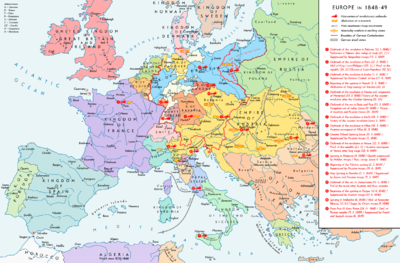
Map of Europe in 1848–1849 depicting the main revolutionary centres, important counter-revolutionary troop movements and states with abdications
The revolutions arose from such a wide variety of causes that it is difficult to view them as resulting from a coherent movement or set of social phenomena. Numerous changes had been taking place in European society throughout the first half of the 19th century. Both liberal reformers and radical politicians were reshaping national governments.
Technological change was revolutionizing the life of the working classes. A popular press extended political awareness, and new values and ideas such as popular liberalism, nationalism and socialism began to emerge. Some historians emphasize the serious crop failures, particularly those of 1846, that produced hardship among peasants and the working urban poor.
Large swaths of the nobility were discontented with royal absolutism or near-absolutism. In 1846, there had been an uprising of Polish nobility in Austrian Galicia, which was only countered when peasants, in turn, rose up against the nobles.[5] Additionally, an uprising by democratic forces against Prussia, planned but not actually carried out, occurred in Greater Poland.[clarification needed]
Next, the middle classes began to agitate. Karl Marx and Friedrich Engels, working in Brussels, had written Manifesto of the Communist Party (published in German in London on February 21, 1848) at the request of the Communist League (an organization consisting principally of German workers). Following the March insurrection in Berlin, they began agitating in Germany. They issued their "Demands of the Communist Party in Germany" from Paris in March;[6] the pamphlet urged unification of Germany, universal suffrage, abolition of feudal duties, and similar middle-class goals.
The middle and working classes thus shared a desire for reform, and agreed on many of the specific aims. Their participations in the revolutions, however, differed. While much of the impetus came from the middle classes, much of the cannon fodder came from the lower classes. The revolts first erupted in the cities.
Urban workers[edit]
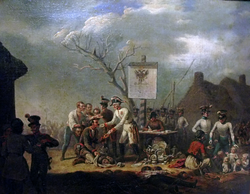
Galician slaughter (Polish: Rzeź galicyjska) by Jan Lewicki (1795–1871), depicting the massacre of Polish nobles by Polish peasants in Galicia in 1846.
The population in French rural areas had risen rapidly, causing many peasants to seek a living in the cities. Many in the bourgeoisie feared and distanced themselves from the working poor. Many unskilled labourers toiled from 12 to 15 hours per day when they had work, living in squalid, disease-ridden slums. Traditional artisans felt the pressure of industrialization, having lost their guilds. Revolutionaries such as Karl Marx built up a following.[7]
The liberalisation of trade laws and the growth of factories had increased the gulf among master tradesmen, and journeymen and apprentices, whose numbers increased disproportionately by 93% from 1815 to 1848 in Germany. Significant proletarian unrest had occurred in Lyon in 1831 and 1834, and Prague in 1844. Jonathan Sperber has suggested that in the period after 1825, poorer urban workers (particularly day labourers, factory workers and artisans) saw their purchasing power decline relatively steeply: urban meat consumption in Belgium, France and Germany stagnated or declined after 1830, despite growing populations.[8] The economic crisis of 1847 increased urban unemployment: 10,000 Viennese factory workers were made redundant and 128 Hamburg firms went bankrupt over the course of 1847.[9] With the exception of the Netherlands, there was a strong correlation among the countries that were most deeply affected by the industrial shock of 1847 and those that underwent a revolution in 1848.[10]
The situation in the German states was similar. Parts of Prussia were beginning to industrialize. During the decade of the 1840s, mechanized production in the textile industry brought about inexpensive clothing that undercut the handmade products of German tailors.[11] Reforms ameliorated the most unpopular features of rural feudalism, but industrial workers remained dissatisfied with these and pressed for greater change.
Urban workers had no choice but to spend half of their income on food, which consisted mostly of bread and potatoes. As a result of harvest failures, food prices soared and the demand for manufactured goods decreased, causing an increase in unemployment. During the revolution, to address the problem of unemployment, workshops were organized for men interested in construction work. Officials also set up workshops for women when they felt they were excluded. Artisans and unemployed workers destroyed industrial machines when they threatened to give employers more power over them.[12][13]
Rural areas[edit]
Rural population growth had led to food shortages, land pressure, and migration, both within and from Europe, especially to the Americas. Peasant discontent in the 1840s grew in intensity: peasant occupations of lost communal land increased in many areas: those convicted of wood theft in the Rhenish Palatinate increased from 100,000 in 1829–30 to 185,000 in 1846–47.[14] In the years 1845 and 1846, a potato blight caused a subsistence crisis in Northern Europe, and encouraged the raiding of manorial potato stocks in Silesia in 1847. The effects of the blight were most severely manifested in the Great Irish Famine,[15] but also caused famine-like conditions in the Scottish Highlands and throughout continental Europe. Harvests of rye in the Rhineland were 20% of previous levels, while the Czech potato harvest was reduced by a half.[16] These reduced harvests were accompanied by a steep rise in prices (the cost of wheat more than doubled in France and Habsburg Italy. There were 400 French food riots during 1846 to 1847, while German socio-economic protests increased from 28 during 1830 to 39, to 103 during 1840 to 1847.[17] Central to long-term peasant grievances were the loss of communal lands, forest restrictions (such as the French Forest Code of 1827), and remaining feudal structures, notably the robot (labour obligations) that existed among the serfs and oppressed peasantry of the Habsburg lands.[18]
Aristocratic wealth (and corresponding power) was synonymous with the ownership of farm lands and effective control over the peasants. Peasant grievances exploded during the revolutionary year of 1848, yet were often disconnected from urban revolutionary movements: the revolutionary Sándor Petőfi's popular nationalist rhetoric in Budapest did not translate into any success with the Magyar peasantry, while the Viennese democrat Hans Kudlich reported that his efforts to galvanise the Austrian peasantry had 'disappeared in the great sea of indifference and phlegm'.[19]
Role of ideas[edit]
Despite forceful and often violent efforts of established and reactionary powers to keep them down, disruptive ideas gained popularity: democracy, liberalism, nationalism, and socialism.[20] They demanded a constitution, press freedom, freedom of expression and other democratic rights, the establishment of civilian militia, liberation of peasants, liberalization of the economy, abolition of tariff barriers and the abolition of monarchical power structures in favor of the establishment of republican states, or at least the restriction of the prince power in the form of constitutional monarchies.
In the language of the 1840s, 'democracy' meant universal male suffrage. 'Liberalism' fundamentally meant consent of the governed and the restriction of church and state power, republican government, freedom of the press and the individual. The 1840s had seen the emergence of a number of radical liberal publications such as the Rheinische Zeitung (1842); Le National and La Réforme (1843) in France; Ignaz Kuranda's Grenzboten (1841) in Austria; Lajos Kossuth's Pesti Hírlap (1841) in Hungary, as well as the increased popularity of the older Morgenbladet in Norway and the Aftonbladet in Sweden.[21]
'Nationalism' believed in uniting people bound by (some mix of) common languages, culture, religion, shared history, and of course immediate geography; there were also irredentist movements. Nationalism had developed a broader appeal during the pre-1848 period, as seen in the František Palacký's 1836 History of the Czech Nation, which emphasised a national lineage of conflict with the Germans, or the popular patriotic Liederkranz (song-circles) that were held across Germany: patriotic and belligerent songs about Schleswig had dominated the Würzburg national song festival in 1845.[22]
'Socialism' in the 1840s was a term without a consensus definition, meaning different things to different people, but was typically used within a context of more power for workers in a system based on worker ownership of the means of production.
Events by country or region[edit]
Italian states[edit]
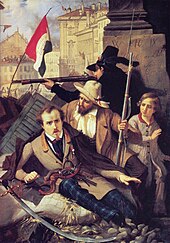
Episode from the Five Days of Milan, painting by Baldassare Verazzi
Although little noticed at the time, the first major outbreak came in Sicily, starting in January 1848. There had been several previous revolts against Bourbon rule; this one produced an independent state that lasted only 16 months before the Bourbons came back. During those months, the constitution was quite advanced for its time in liberal democratic terms, as was the proposal of an Italian confederation of states.[citation needed] The revolt's failure was reversed a dozen years later as the Bourbon kingdom of the Two Sicilies collapsed in 1860–61 with the Risorgimento.
France[edit]
The "February Revolution" in France was sparked by the suppression of the campagne des banquets. This revolution was driven by nationalist and republican ideals among the French general public, who believed the people should rule themselves. It ended the constitutional monarchy of Louis-Philippe, and led to the creation of the French Second Republic. This government was headed by Louis-Napoleon, who, after only four years, established the Second French Empire in 1852.
Alexis de Tocqueville remarked in his Recollections of the period, "society was cut in two: those who had nothing united in common envy, and those who had anything united in common terror."[23]
German states[edit]

Revolutionaries in Berlin in March 1848, waving the revolutionary flags
The "March Revolution" in the German states took place in the south and the west of Germany, with large popular assemblies and mass demonstrations. Led by well-educated students and intellectuals,[24] they demanded German national unity, freedom of the press, and freedom of assembly. The uprisings were not well coordinated, but had in common a rejection of traditional, autocratic political structures in the 39 independent states of the German Confederation. The middle-class and working-class components of the Revolution split, and in the end, the conservative aristocracy defeated it, forcing many liberals into exile.[25]
Denmark[edit]

Danish soldiers parade through Copenhagen in 1849 after victories in the First Schleswig War
Denmark had been governed by a system of absolute monarchy since the 17th century. King Christian VIII, a moderate reformer but still an absolutist, died in January 1848 during a period of rising opposition from farmers and liberals. The demands for constitutional monarchy, led by the National Liberals, ended with a popular march to Christiansborg on March 21. The new king, Frederick VII, met the liberals' demands and installed a new Cabinet that included prominent leaders of the National Liberal Party.[26]
The national-liberal movement wanted to abolish absolutism, but retain a strongly centralized state. The king accepted a new constitution agreeing to share power with a bicameral parliament called the Rigsdag. It is said that the Danish king's first words after signing away his absolute power were, "that was nice, now I can sleep in the mornings".[27] Although army officers were dissatisfied, they accepted the new arrangement which, in contrast to the rest of Europe, was not overturned by reactionaries.[26] The liberal constitution did not extend to Schleswig, leaving the Schleswig-Holstein Question unanswered.
Schleswig[edit]
Schleswig, a region containing both Danes (a North Germanic population) and Germans (a West Germanic population), was a part of the Danish monarchy, but remained a duchy separate from the Kingdom of Denmark. Spurred by pan-German sentiment, the Germans of Schleswig took up arms to protest a new policy announced by Denmark's National Liberal government, which would have fully integrated the duchy into Denmark.
The German population in Schleswig and Holstein revolted, inspired by the Protestant clergy. The German states sent in an army, but Danish victories in 1849 led to the Treaty of Berlin (1850) and the London Protocol (1852). They reaffirmed the sovereignty of the King of Denmark, while prohibiting union with Denmark. The violation of the latter provision led to renewed warfare in 1863 and the Prussian victory in 1864.
Habsburg Empire[edit]
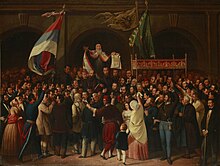
Proclamation of the Serbian Vojvodina in May 1848
From March 1848 through July 1849, the Habsburg Austrian Empire was threatened by revolutionary movements, which often had a nationalist character. The empire, ruled from Vienna, included Austrians, Hungarians, Slovenes, Poles, Czechs, Croats, Slovaks, Ukrainians/Ruthenians, Romanians, Serbs and Italians, all of whom attempted in the course of the revolution to achieve either autonomy, independence, or even hegemony over other nationalities.[citation needed] The nationalist picture was further complicated by the simultaneous events in the German states, which moved toward greater German national unity.
Hungary[edit]
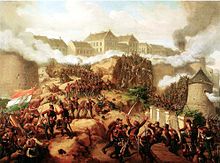
The Battle of Buda in May 1849 by Mór Than
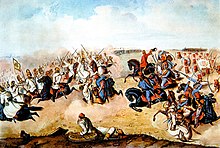
Hungarian hussars in battle during the Hungarian Revolution
The Hungarian revolution of 1848 was the longest in Europe, crushed in August 1849 by Austrian and Russian armies. Nevertheless, it had a major impact in freeing the serfs.[28] It started on 15 March 1848, when Hungarian patriots organized mass demonstrations in Pest and Buda (today Budapest) which forced the imperial governor to accept their 12 points of demands, which included the demand for freedom of press, an independent Hungarian ministry residing in Buda-Pest and responsible to a popularly elected parliament, the formation of a National Guard, complete civil and religious equality, trial by jury, a national bank, a Hungarian army, the withdrawal of foreign troops from Hungary (Austrian troops), the freeing of political prisoners, and the union with Transylvania. On that morning, the demands were read aloud along with poetry by Sándor Petőfi with the simple lines of "We swear by the God of the Hungarians. We swear, we shall be slaves no more".[29]Lajos Kossuth and some other liberal nobility that made up the Diet appealed to the Habsburg court with demands for representative government and civil liberties.[30] These events resulted in Klemens von Metternich, the Austrian prince and foreign minister, resigning. The demands of the Diet were agreed upon on March 18 by Emperor Ferdinand. Even though Hungary would remain part of the Empire through personal union with the emperor, a constitutional government would be founded. The Diet then passed the April laws that established equality before the law, a legislature, a hereditary constitutional monarchy, and an end to the transfer and restrictions of land use.[30]
The revolution grew into a war for independence from the Austrian Empire when Josip Jelačić, Ban of Croatia, crossed the border to restore Habsburg control.[31] The new government, led by Lajos Kossuth, was initially successful against the Habsburg forces. Although Hungary took a national united stand for its freedom, some minorities of the Kingdom of Hungary, including the Serbs of Vojvodina, the Romanians of Transylvania and some Slovaks of Upper Hungary supported the Habsburg Emperor and fought against the Hungarian Revolutionary Army. Eventually, after one and a half years of fighting, the revolution was crushed when Russian Tsar Nicholas I marched into Hungary with over 300,000 troops. Hungary was thus placed under brutal martial law, with the Austrian government restored. The leading rebels like Kossuth fled into exile or were executed. In the long run, the passive resistance following the revolution led to the Austro-Hungarian Compromise (1867), which marked the birth of the Austro-Hungarian Empire.
Galicia[edit]
The center of the Ukrainian national movement was in Galicia, which is today divided between Ukraine and Poland. On April 19, 1848, a group of representatives led by the Greek Catholic clergy launched a petition to the Austrian Emperor. It expressed wishes that in those regions of Galicia where the Ruthenian (Ukrainian) population represented majority, the Ukrainian language should be taught at schools and used to announce official decrees for the peasantry; local officials were expected to understand it and the Ruthenian clergy was to be equalized in their rights with the clergy of all other denominations.[32]
On May 2, 1848, the Supreme Ruthenian (Ukrainian) Council was established. The Council (1848–1851) was headed by the Greek-Catholic Bishop Gregory Yakhimovich and consisted of 30 permanent members. Its main goal was the administrative division of Galicia into Western (Polish) and Eastern (Ruthenian/Ukrainian) parts within the borders of the Habsburg Empire, and formation of a separate region with a political self-governance.[33]
Sweden[edit]
During 18–19 March, a series of riots known as the March Unrest (Marsoroligheterna) took place in the Swedish capital of Stockholm. Declarations with demands of political reform were spread in the city and a crowd were dispersed by the military, leading to 18 casualties.
Switzerland[edit]
Switzerland, already an alliance of republics, also saw an internal struggle. The attempted secession of seven Swiss cantons to form an alliance known as the Sonderbund ("separate alliance") in 1845 led to a short civil conflict in November 1847 in which around 100 people were killed. The Sonderbund was decisively defeated, and a new constitution of 1848 ended the almost-complete independence of the cantons, transforming Switzerland into a federal state.
Greater Poland[edit]
Polish people mounted a military insurrection against the Prussians in the Grand Duchy of Posen (or the Greater Poland region), a part of Prussia since its annexation in 1815.
Danubian Principalities[edit]
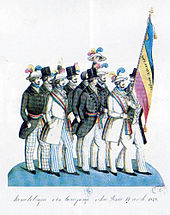
Romanian revolutionaries in Bucharest in 1848, carrying the Romanian tricolor
A Romanian liberal and Romantic nationalist uprising began in June in the principality of Wallachia. Closely connected with the 1848 unsuccessful revolt in Moldavia, it sought to overturn the administration imposed by Imperial Russian authorities under the Regulamentul Organic regime, and, through many of its leaders, demanded the abolition of boyar privilege. Led by a group of young intellectuals and officers in the Wallachian military forces, the movement succeeded in toppling the ruling Prince Gheorghe Bibescu, whom it replaced with a provisional government and a regency, and in passing a series of major liberal reforms, first announced in the Proclamation of Islaz.
Belgium[edit]
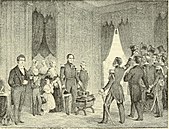
A depiction of Leopold I of Belgium's symbolic offer to resign the crown in 1848
Belgium did not see major unrest in 1848, although numerous small-scale confrontations did occur. A number of local riots broke out, concentrated in the sillon industriel industrial region of the provinces of Liège and Hainaut. The most serious threat of revolutionary contagion was posed by Belgian émigré groups from France. Shortly after the revolution in France, Belgian migrant workers living in Paris were encouraged to return to Belgium to overthrow the monarchy and establish a republic.[34] Karl Marx was himself expelled from Brussels in early March on accusations of having used part of his inheritance to arm Belgian revolutionaries.
Around 6,000 armed émigrés of the "Belgian Legion" attempted to cross the Belgian frontier. There were two divisions which were formed. The first group, travelling by train, were stopped and quickly disarmed at Quiévrain on 26 March 1848.[35] The second group crossed the border on 29 March and headed for Brussels.[34] They were confronted by Belgian troops at the hamlet of Risquons-Tout and defeated.[34] Several smaller groups managed to infiltrate Belgium, but the reinforced Belgian border troops were successful and the defeat at Risquons-Tout effectively ended the revolutionary threat to Belgium. The situation in Belgium began to recover that summer after a good harvest, and fresh elections returned a strong majority to the governing party.[34]
Ireland[edit]
Occurring during the Great Famine, in late 1847 the "Crime and Outrage Bill" was passed by the British Parliament regarding crime in Ireland, which was then part of the United Kingdom of Great Britain and Ireland. The Bill was designed with the expressed intent to create a counter-insurgency for the growing Irish nationalist agitation that was causing the British government concern about a possible violent rebellion against British rule in Ireland.[36]
In 1848 the Young Irelander Rebellion would be a failed Irish nationalist uprising led by the Young Ireland movement, part of the wider Revolutions of 1848 that affected most of Europe. It took place on 29 July 1848 in the village of Ballingarry, South Tipperary. The Young Irelanders and their supporters, chased an armed Royal Irish Constabulary unit of nearly 50 men who would retreat and then garrison themselves in a house, holding those inside as hostages. A several-hour gunfight followed, but the rebels fled after a large group of Constabulary reinforcements arrived.
It is sometimes called the Famine Rebellion (since it took place during the Great Famine in Ireland) or the Battle of Ballingarry.
As with the earlier United Irishmen's mass Rebellion in 1798, who sought to emulate the American Revolution, and Robert Emmet's Rising in 1803, the Young Irelanders were inspired by republicanism in the United States and (to a lesser extent) Europe.
Other European states[edit]

Illustration of the "March troubles" in Stockholm, Sweden in 1848
Great Britain, Belgium, Netherlands, Portugal, Spain, the Russian Empire (including Poland and Finland), and the Ottoman Empire did not encounter major national revolutions over this period. Sweden and Norway were also little affected. Serbia, though formally unaffected by the revolt as it was a part of the Ottoman state, actively supported Serbian revolutionaries in the Habsburg Empire.[37]
Russia's relative stability was attributed to the revolutionary groups' inability to communicate with each other.[citation needed] In the Kingdom of Poland and the Grand Duchy of Lithuania, uprisings took place in 1830–31 (the November Uprising) and 1846 (the Kraków Uprising, notable for being quelled by the anti-revolutionary Galician slaughter). A final revolt took place in 1863–65 (the January Uprising), but none occurred in 1848.
Switzerland and Portugal were also unaffected in 1848, though both had gone through civil wars in the preceding years (the Sonderbund War in Switzerland and the Liberal Wars in Portugal). The introduction of the Swiss Federal Constitution in 1848 was a revolution of sorts, laying the foundation of Swiss society as it is today.
In the Netherlands, no major unrests appeared because the king, William II, decided to alter the Dutch constitution to reform elections and effectively reduce the power of the monarchy.
While no major political upheavals occurred in the Ottoman Empire as such, political unrest did occur in some of its vassal states. In Serbia, feudalism was abolished and the power of the Serbian prince was reduced with the Turkish Constitution of Serbia in 1838.
Other English-speaking countries[edit]

Chartist meeting on Kennington Common 10 April 1848
In Britain, the middle classes had been pacified by general enfranchisement in the Reform Act 1832; the consequent agitations, violence, and petitions of the Chartist movement came to a head with their peaceful petition to Parliament of 1848. The repeal in 1846 of the protectionist agricultural tariffs – called the "Corn Laws" – had defused some proletarian fervour.[38]
In the Isle of Man, there were ongoing efforts to reform the self-elected House of Keys, but no revolution took place. Some of the reformers were encouraged by events in France in particular.[39]
In the United States, the main impact of the revolutions and their failure was substantially increased immigration, especially from Germany. This, in turn, fuelled the nativist "Know Nothing" movement in the years preceding the American Civil War. The "Know Nothings" were opposed to Catholic immigration, especially immigration of German and Irish Catholics, and held Pope Pius IX responsible for the 1848 revolutions' failure.
1848 in Canada saw the establishment of responsible government in Nova Scotia and The Canadas, the first such governments in the British Empire outside of Great Britain itself. John Ralston Saul has argued that this development is tied to the revolutions in Europe, but described the Canadian approach to the revolutionary year of 1848 as "talking their way...out of the empire's control system and into a new democratic model", a stable democratic system which has lasted to the present day.[40]Tory and Orange Order in Canada opposition to responsible government came to a head in riots triggered by the Rebellion Losses Bill in 1849. They succeeded in the burning of the Parliament Buildings in Montreal, but, unlike their counterrevolutionary counterparts in Europe, they were ultimately unsuccessful.[citation needed]
South America[edit]
In Spanish Latin America, the Revolution of 1848 appeared in New Granada, where Colombian students, liberals, and intellectuals demanded the election of General José Hilario López. He took power in 1849 and launched major reforms, abolishing slavery and the death penalty, and providing freedom of the press and of religion. The resulting turmoil in Colombia lasted four decades; from 1851 to 1885, the country was ravaged by four general civil wars and 50 local revolutions.[41]
In Chile, the 1848 revolutions inspired the 1851 Chilean Revolution.[42]
In Brazil, the "Praieira Revolt," a movement in Pernambuco, lasted from November 1848 to 1852.[citation needed] Unresolved conflicts left over from the period of the regency and local resistance to the consolidation of the Brazilian Empire that had been proclaimed in 1822 helped to plant the seeds of the revolution.
Legacy[edit]
.mw-parser-output .templatequoteoverflow:hidden;margin:1em 0;padding:0 40px.mw-parser-output .templatequote .templatequoteciteline-height:1.5em;text-align:left;padding-left:1.6em;margin-top:0
We have been beaten and humiliated ... scattered, imprisoned, disarmed and gagged. The fate of European democracy has slipped from our hands.
— Pierre-Joseph Proudhon[43]
Democrats looked to 1848 as a democratic revolution, which in the long run ensured liberty, equality, and fraternity. For nationalists, 1848 was the springtime of hope, when newly emerging nationalities rejected the old multinational empires. But the end results were not as comprehensive as many had hoped.

A caricature by Ferdinand Schröder on the defeat of the revolutions of 1848/49 in Europe (published in Düsseldorfer Monatshefte, August 1849)
Many governments engaged in a partial reversal of the revolutionary reforms of 1848–1849, as well as heightened repression and censorship. The Hanoverian nobility successfully appealed to the Confederal Diet in 1851 over the loss of their noble privileges, while the Prussian Junkers recovered their manorial police powers from 1852 to 1855.[44][45] In the Austrian Empire, the Sylvester Patents (1851) discarded Franz Stadion's constitution and the Statute of Basic Rights, while the number of arrests in Habsburg territories increased from 70,000 in 1850 to one million by 1854.[46] Nicholas I's rule in Russia after 1848 was particularly repressive, marked by an expansion of the secret police (the Tretiye Otdeleniye) and stricter censorship; there were more Russians working for censorship organs than actual books published in the period immediately after 1848.[47][48] In France, the works of Ledru-Rollin, Hugo, Baudelaire and Proudhon were confiscated.[49]
In the post-revolutionary decade after 1848, little had visibly changed, and many historians considered the revolutions a failure, given the seeming lack of permanent structural changes. More recently, Christopher Clark has characterised the period that followed 1848 as one dominated by a 'revolution in government'. Karl Marx expressed disappointment at the bourgeois character of the revolutions.[50] The Prussian Prime Minister Otto von Manteuffel declared that the state could no longer be run 'like the landed estate of a nobleman'. In Prussia, August von Bethmann-Hollweg's Preußisches Wochenblatt newspaper (founded 1851) acted as a popular outlet for modernising Prussian conservative statesmen and journalists against the reactionary Kreuzzeitung faction. The revolutions of 1848 were followed by new centrist coalitions dominated by liberals nervous of the threat of working-class socialism, as seen in the Piedmontese Connubio under Cavour.[51][52][53]
Governments after 1848 were forced into managing the public sphere and popular sphere with more effectiveness, resulting in the increased prominence of the Prussian Zentralstelle für Pressangelegenheiten (Central Press Agency, established 1850), the Austrian Zensur-und polizeihofstelle, and the French Direction Générale de la Librairie (1856).[54]
Nevertheless, there were a few immediate successes for some revolutionary movements, notably in the Habsburg lands. Austria and Prussia eliminated feudalism by 1850, improving the lot of the peasants. European middle classes made political and economic gains over the next 20 years; France retained universal male suffrage. Russia would later free the serfs on February 19, 1861. The Habsburgs finally had to give the Hungarians more self-determination in the Ausgleich of 1867. The revolutions inspired lasting reform in Denmark, as well as the Netherlands.
Reinhard Rürup has described the 1848 Revolutions as a turning point in the development of modern antisemitism through the development of conspiracies that presented Jews as representative both of the forces of social revolution (apparently typified in Joseph Goldmark and Adolf Fischhof of Vienna) and of international capital, as seen in the 1848 report from Eduard von Müller-Tellering, the Viennese correspondent of Marx's Neue Rheinische Zeitung, which declared: "tyranny comes from money and the money belongs to the Jews".[55]
The Texas Hill Country was settled by German intellectuals fleeing the reactionary purges[56] (German Texans). More widely, many disillusioned and persecuted revolutionaries, in particular (though not exclusively) those from Germany and the Austrian Empire, left their homelands for foreign exile in the New World or in the more liberal European nations: these emigrants were known as the Forty-Eighters.
In popular culture[edit]
Steven Brust and Emma Bull's 1997 epistolary novel Freedom & Necessity is set in England in the aftermath of the Revolutions of 1848.[57]
Mike Duncan's Revolutions Podcast series covered the Revolutions of 1848 starting with episode 7.01.
See also[edit]
- Arab Spring
- Color Revolutions
- Protests of 1968
- Revolutions of 1830
- Revolutions of 1917–23
- Revolutions of 1989
References[edit]
^ 1848-06-24 (1848-06-24): "Battle at Soufflot barricades-1848" Location:Rue Soufflot, Paris48°50′48″N 2°20′37″E / 48.846792°N 2.343473°E / 48.846792; 2.343473 (1848-06-24: Battle at Soufflot barricades-1848) (linkback://en.wikipedia.org/wiki/Revolutions_of_1848)
^ Mike Rapport (2009). 1848: Year of Revolution. Basic Books. p. 201. ISBN 978-0-465-01436-1.The first deaths came at noon on 23 June.
.mw-parser-output cite.citationfont-style:inherit.mw-parser-output qquotes:"""""""'""'".mw-parser-output code.cs1-codecolor:inherit;background:inherit;border:inherit;padding:inherit.mw-parser-output .cs1-lock-free abackground:url("//upload.wikimedia.org/wikipedia/commons/thumb/6/65/Lock-green.svg/9px-Lock-green.svg.png")no-repeat;background-position:right .1em center.mw-parser-output .cs1-lock-limited a,.mw-parser-output .cs1-lock-registration abackground:url("//upload.wikimedia.org/wikipedia/commons/thumb/d/d6/Lock-gray-alt-2.svg/9px-Lock-gray-alt-2.svg.png")no-repeat;background-position:right .1em center.mw-parser-output .cs1-lock-subscription abackground:url("//upload.wikimedia.org/wikipedia/commons/thumb/a/aa/Lock-red-alt-2.svg/9px-Lock-red-alt-2.svg.png")no-repeat;background-position:right .1em center.mw-parser-output .cs1-subscription,.mw-parser-output .cs1-registrationcolor:#555.mw-parser-output .cs1-subscription span,.mw-parser-output .cs1-registration spanborder-bottom:1px dotted;cursor:help.mw-parser-output .cs1-hidden-errordisplay:none;font-size:100%.mw-parser-output .cs1-visible-errorfont-size:100%.mw-parser-output .cs1-subscription,.mw-parser-output .cs1-registration,.mw-parser-output .cs1-formatfont-size:95%.mw-parser-output .cs1-kern-left,.mw-parser-output .cs1-kern-wl-leftpadding-left:0.2em.mw-parser-output .cs1-kern-right,.mw-parser-output .cs1-kern-wl-rightpadding-right:0.2em
^ Merriman, John, A History of Modern Europe: From the French Revolution to the Present, 1996, p. 715
^ R.J.W. Evans and Hartmut Pogge von Strandmann, eds., The Revolutions in Europe 1848–1849 (2000) pp. v, 4
^ Robert Bideleux and Ian Jeffries, A History of Eastern Europe: Crisis and Change, Routledge, 1998.
ISBN 0415161118. pp. 295–96.
^ "Demands of the Communist Party in Germany," Marx-Engels Collected Works, vol 7, pp. 3ff (Progress Publishers: 1975–2005)
^ Merriman, John (1996). A History of Modern Europe: From the Renaissance to the Present. New York: W.W. Norton. p. 718.
^ Siemann, Wolfram, The German Revolution of 1848–1849 (London, 1998), p. 27; Lèvêque, Pierre in Dowe, p. 93; Pech, Stanley Z. The Czech Revolution of 1848 (London, 1969), p. 14
^ Siemann (1998); Pech, p. 14
^ Berger, Helge, and Mark Spoerer. "Economic Crises and the European Revolutions of 1848." The Journal of Economic History 61.2 (2001), p. 305
^ Merriman, 1996, p. 724
^ Berg, Maxine (1982-02-04). The Machinery Question and the Making of Political Economy 1815-1848. ISBN 9780521287593.
^ Breuilly, John ed. Parker, David (2000). Revolutions and the Revolutionary Tradition. New York: Routledge. p. 114.CS1 maint: Multiple names: authors list (link)
^ Sperber, Jonathan. The European Revolutions of 1848 (1994)p.90
^ Helen Litton, The Irish Famine: An Illustrated History, Wolfhound Press, 1995,
ISBN 0-86327-912-0
^ Sperber, Jonathan, Rhineland Radicals: The Democratic Movement and the Revolution of 1848 (Princeton, 1991), p. 140; Pech, Stanley Z. The Czech Revolution of 1848 (London, 1969), p. 45
^ Siemann, Wolfram, The German Revolution of 1848–1849 (London, 1998), p. 39
^ Rath, Reuben J. The Viennese Revolution of 1848 (New York, 1969), p. 12 Sperber, Jonathan. The European Revolutions of 1848 (1994), p. 40
^ Sperber, Jonathan. The European Revolutions of 1848 (1994), pp. 152, 232.
^ Charles Breunig, The Age of Revolution and Reaction, 1789–1850 (1977)
^ Sperber (1994) pp. 99, 113; Ginsborg, p. 44;
^ Stanley Z. Pech, The Czech Revolution of 1848 (1969), p. 25, Wolfram Siemann, The German Revolution of 1848–1849 (London, 1998), p. 47
^ Tocqueville, Alexis de. "Recollections," 1893
^ Louis Namier, 1848: The Revolution of the Intellectuals (1964)
^ Theodote S. Hamerow, Restoration, Revolution, Reaction: Economics and Politics in Germany, 1825–1870 (1958) focuses mainly on artisans and peasants
^ ab Weibull, Jörgen. "Scandinavia, History of." Encyclopædia Britannica 15th ed., Vol. 16, 324.
^ Olaf Søndberg;
den danske revolution 1830–1866: p. 70, line 47–48
^ Gábor Gángó, "1848–1849 in Hungary," Hungarian Studies (2001) 15#1 pp. 39–47. online
^ Deak, Istvan. The Lawful Revolution. New York: Columbia University Press, 1979.
^ ab "The US and the 1848 Hungarian Revolution." The Hungarian Initiatives Foundation. Accessed March 26, 2015. http://www.hungaryfoundation.org/history/20140707_US_HUN_1848.
^ The Making of the West: Volume C, Lynn Hunt, pp. 683–84
^ Kost' Levytskyi, The History of the Political Thought of the Galician Ukrainians, 1848–1914, (Lviv, 1926), 17.
^ Kost' Levytskyi, The History of the Political Thought of the Galician Ukrainians, 1848–1914, (Lviv, 1926), 26.
^ abcd Chastain, James. "Belgium in 1848". Encyclopedia of 1848 Revolutions. Ohio University. Archived from the original on 2011-08-11.
^ Ascherson, Neal (1999). The King Incorporated: Leopold the Second and the Congo (New ed.). London: Granta. pp. 20–21. ISBN 978-1862072909.
^ Woodham-Smith, Cecil The Great Hunger Ireland1845 1849 Harper and Row New york pages 326-327
^ "Serbia's Role in the Conflict in Vojvodina, 1848–49". Ohiou.edu. 2004-10-25. Archived from the original on 2008-09-25. Retrieved 2013-10-01.
^ Henry Weisser, "Chartism in 1848: Reflections on a Non-Revolution," Albion: A Quarterly Journal Concerned with British Studies Vol. 13, No. 1 (Spring, 1981), pp. 12–26 in JSTOR
^ Fyson, Robert (2016). The Struggle for Manx Democracy. Douglas: Culture Vannin. ISBN 9780993157837.
^ Saul, J.R. (2012). Louis-Hippolyte LaFontaine & Robert Baldwin. Penguin Group (Canada).
^ J. Fred Rippy, Latin America: A Modern History (1958) pp. 253–54
^ Gazmuri, Cristián (1999). El "1849" chileno: Igualitarios, reformistas, radicales, masones y bomberos (PDF) (in Spanish). Santiago, Chile: Editorial Universitaria. p. 104. Retrieved June 1, 2014.
^ Breunig, Charles (1977), The Age of Revolution and Reaction, 1789–1850 (
ISBN 0-393-09143-0)
^ Green, Abigail, Fatherlands: State-Building and Nationhood in Nineteenth-Century Germany (Cambridge, 2001), p. 75
^ Barclay, David, Friedrich Wilhelm IV and the Prussian Monarchy 1840–1861 (Oxford, 1995), pp. 190, 231
^ Deak, John. Forging a Multinational State: State Making in Imperial Austria from the Enlightenment to the First World War (Stanford, 2015), p. 105
^ Westwood, J. N. Endurance and Endeavour: Russian History, 1812–1980. Oxford (2002), p. 32
^ Goldfrank, David M. The Origins of the Crimean War. London: Longman, (1994), p. 21
^ Price, Roger. The French Second Empire: An Anatomy of Political Power (Cambridge, 2001), p. 327.
^ "England and Revolution by Marx 1848". Marxists Internet Archive. Retrieved November 16, 2018.
^ Brophy, James M. Capitalism, Politics and Railroads in Prussia 1830–1870 (Columbus, 1998), p. 1
^ Schroeder, Paul in Blanning, T. C. W. (ed.), The Short Oxford History of Europe: The Nineteenth Century (Oxford, 2000), p. 171
^ Smith, Denis Mack. Cavour (Knopf, 1985), p. 91
^ Clark, p. 184
^ "Progress and Its Limits: The Revolution of 1848 and European Jewry". Reinhard Rürup in Dowe, Dieter ed., Europe in 1848: Revolution and Reform (Oxford, 2001), pp. 758, 761
^ Forty-Eighters from the Handbook of Texas Online
^ Brust, Steven; Bull, Emma (1997). Freedom and Necessity. New York: Tor Books. ISBN 9780812562613. Retrieved August 2, 2017.
Bibliography[edit]
Surveys[edit]
- Breunig, Charles (1977), The Age of Revolution and Reaction, 1789–1850 (
ISBN 0-393-09143-0) - Chastain, James, ed. (2005) Encyclopedia of Revolutions of 1848 online from Ohio State U.
- Dowe, Dieter, ed. Europe in 1848: Revolution and Reform (Berghahn Books, 2000)
- Evans, R.J.W., and Hartmut Pogge von Strandmann, eds. The Revolutions in Europe, 1848–1849: From Reform to Reaction (2000), 10 essays by scholars excerpt and text search
- Pouthas, Charles. "The Revolutions of 1848" in J. P. T. Bury, ed. New Cambridge Modern History: The zenith of European power 1830–70 (1960) pp. 389–415 online excerpts
- Langer, William. The Revolutions of 1848 (Harper, 1971), standard overview
- Rapport, Mike (2009), 1848: Year of Revolution
ISBN 978-0-465-01436-1 online review, a standard survey - Robertson, Priscilla (1952), Revolutions of 1848: A Social History (
ISBN 0-691-00756-X), despite the subtitle this is a traditional political narrative - Sperber, Jonathan. The European revolutions, 1848–1851 (1994) online edition
- Stearns, Peter N. The Revolutions of 1848 (1974). online edition
- Weyland, Kurt. "The Diffusion of Revolution: '1848' in Europe and Latin America," International Organization Vol. 63, No. 3 (Summer, 2009) pp. 391–423 in JSTOR
France[edit]
- Duveau, Georges. 1848: The Making of a Revolution (1966)
- Fasel, George. "The Wrong Revolution: French Republicanism in 1848," French Historical Studies Vol. 8, No. 4 (Autumn, 1974), pp. 654–77 in JSTOR
- Loubère, Leo. "The Emergence of the Extreme Left in Lower Languedoc, 1848–1851: Social and Economic Factors in Politics," American Historical Review (1968), v. 73#4 1019–51 in JSTOR
Germany and Austria[edit]
- Deak, Istvan. The Lawful Revolution: Louis Kossuth and the Hungarians, 1848–1849 (1979)
- Hahs, Hans J. The 1848 Revolutions in German-speaking Europe (2001)
- Hewitson, Mark. "'The Old Forms are Breaking Up, ... Our New Germany is Rebuilding Itself': Constitutionalism, Nationalism and the Creation of a German Polity during the Revolutions of 1848–49," English Historical Review, Oct 2010, Vol. 125 Issue 516, pp. 1173–1214 online
- Macartney, C. A. "1848 in the Habsburg Monarchy," European Studies Review, 1977, Vol. 7 Issue 3, pp. 285–309 online
- O'Boyle Lenore. "The Democratic Left in Germany, 1848," Journal of Modern History Vol. 33, No. 4 (Dec., 1961), pp. 374–83 in JSTOR
- Robertson, Priscilla. Revolutions of 1848: A Social History (1952), pp 105–85 on Germany, pp. 187–307 on Austria
- Sked, Alan. The Survival of the Habsburg Empire: Radetzky, the Imperial Army and the Class War, 1848 (1979)
- Vick, Brian. Defining Germany The 1848 Frankfurt Parliamentarians and National Identity (Harvard University Press, 2002)
ISBN 978-0-674-00911-0).
Italy[edit]
- Ginsborg, Paul. "Peasants and Revolutionaries in Venice and the Veneto, 1848," Historical Journal, Sep 1974, Vol. 17 Issue 3, pp. 503–50 in JSTOR
- Ginsborg, Paul. Daniele Manin and the Venetian Revolution of 1848–49 (1979)
- Robertson, Priscilla (1952). Revolutions of 1848: A Social History (1952) pp. 309–401
Other[edit]
- Feyzioğlu, Hamiyet Sezer et al. "Revolutions of 1848 and the Ottoman Empire," Bulgarian Historical Review, 2009, Vol. 37 Issue 3/4, pp. 196–205
Historiography[edit]
- Dénes, Iván Zoltán. "Reinterpreting a 'Founding Father': Kossuth Images and Their Contexts, 1848–2009," East Central Europe, April 2010, Vol. 37 Issue 1, pp. 90–117
- Hamerow, Theodore S. "History and the German Revolution of 1848," American Historical Review Vol. 60, No. 1 (Oct., 1954), pp. 27–44 in JSTOR
- Jones, Peter (1981), The 1848 Revolutions (Seminar Studies in History) (
ISBN 0-582-06106-7) - Mattheisen, Donald J. "History as Current Events: Recent Works on the German Revolution of 1848," American Historical Review, Dec 1983, Vol. 88 Issue 5, pp. 1219–37 in JSTOR
- Rothfels, Hans. "1848 – One Hundred Years After," Journal of Modern History, Dec 1948, Vol. 20 Issue 4, pp. 291–319 in JSTOR
External links[edit]
- The Revolutions of 1848 begin
- Maps of Europe showing the Revolutions of 1848-1849 at omniatlas.com
| Wikimedia Commons has media related to Revolutions of 1848. |
Categories:
- Revolutions of 1848
- Revolutionary waves
- 19th-century revolutions
- 1848 in Europe
- Conflicts in 1848
- European political history
- History of Central Europe
- History of socialism
- Liberalism
- Nationalist movements
- Romanticism
(window.RLQ=window.RLQ||).push(function()mw.config.set("wgPageParseReport":"limitreport":"cputime":"0.796","walltime":"1.009","ppvisitednodes":"value":5482,"limit":1000000,"ppgeneratednodes":"value":0,"limit":1500000,"postexpandincludesize":"value":138550,"limit":2097152,"templateargumentsize":"value":7276,"limit":2097152,"expansiondepth":"value":21,"limit":40,"expensivefunctioncount":"value":7,"limit":500,"unstrip-depth":"value":1,"limit":20,"unstrip-size":"value":60071,"limit":5000000,"entityaccesscount":"value":1,"limit":400,"timingprofile":["100.00% 732.970 1 -total"," 29.69% 217.654 1 Template:Reflist"," 11.61% 85.087 8 Template:Cite_book"," 10.61% 77.748 1 Template:Infobox_historical_event"," 10.22% 74.913 1 Template:Commons_category"," 7.99% 58.543 1 Template:Infobox"," 7.90% 57.939 8 Template:ISBN"," 7.34% 53.824 5 Template:Citation_needed"," 6.32% 46.305 5 Template:Fix"," 6.11% 44.808 1 Template:Clarify"],"scribunto":"limitreport-timeusage":"value":"0.286","limit":"10.000","limitreport-memusage":"value":7000413,"limit":52428800,"cachereport":"origin":"mw1267","timestamp":"20181217064025","ttl":1900800,"transientcontent":false););"@context":"https://schema.org","@type":"Article","name":"Revolutions of 1848","url":"https://en.wikipedia.org/wiki/Revolutions_of_1848","sameAs":"http://www.wikidata.org/entity/Q3588","mainEntity":"http://www.wikidata.org/entity/Q3588","author":"@type":"Organization","name":"Contributors to Wikimedia projects","publisher":"@type":"Organization","name":"Wikimedia Foundation, Inc.","logo":"@type":"ImageObject","url":"https://www.wikimedia.org/static/images/wmf-hor-googpub.png","datePublished":"2003-06-16T22:52:41Z","dateModified":"2018-12-02T01:19:14Z","image":"https://upload.wikimedia.org/wikipedia/commons/c/cd/Horace_Vernet-Barricade_rue_Soufflot.jpg","headline":"series of political upheavals throughout Europe in 1848"(window.RLQ=window.RLQ||).push(function()mw.config.set("wgBackendResponseTime":123,"wgHostname":"mw1268"););


